MENU
(Jan. 8, 2016 - by Harold Goerzen) The news of five missionary deaths in Ecuador at the hands of Waorani warriors in the jungles of Ecuador exactly 60 years ago sent shockwaves around the world.
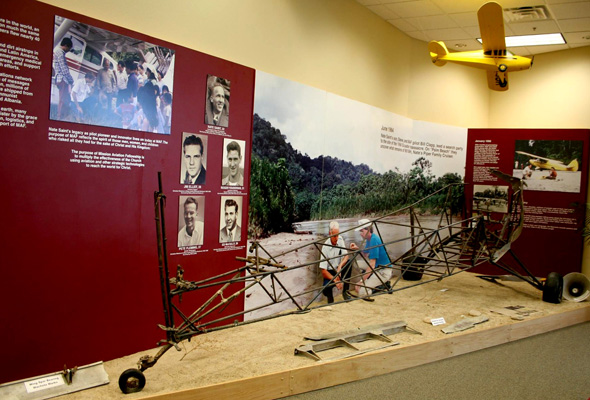 But out of the ashes of this apparent tragedy on Jan. 8, 1956, arose new hope for unreached peoples worldwide. That’s because thousands of people committed themselves to missionary service after hearing this story.
But out of the ashes of this apparent tragedy on Jan. 8, 1956, arose new hope for unreached peoples worldwide. That’s because thousands of people committed themselves to missionary service after hearing this story.
Among those were Richard “Dick” and Jane Farstad who went to Ecuador in 1960 to serve as missionaries with the Brethren organization, Christian Missions in Many Lands. Three of the five martyrs were members of Brethren Assemblies, and the Farstads were convinced they could make a difference by helping reach the unreached in Ecuador.
“We wanted to serve the Lord full time, and when the five missionaries were killed in Ecuador, we were drawn to that country,” Jane said in an interview several years ago.
Ima Jane (Gore) Farstad, born in St. Louis, Mo., on Oct. 26, 1925, died on Dec. 20, 2015, in Plano, Texas, after years of declining health. She was 90 years old.
As a teenager Jane attended a Young Life camp that had a big impact on her life. She gave her life to Christ at the age of 16, having no idea about the adventure or the challenges that were to come.
Preparing for Ministry
After graduating from Normandy High School in St. Louis in 1944, Jane worked as a stenographer at International Shoe Co., and five years later she decided to enroll at Emmaus Bible School, then in Chicago, completing the school’s three-year diploma in 1952. That’s where she met her husband-to-be, Dick Farstad, whom she married on July 18, 1953. Dick had graduated from the same program just months before their marriage.
Together they took part in street meetings as Dick sang in a quartet accompanied by Jane on the piano. Their two children, Mark and Martha “Martie,” were born in 1955 and 1956 respectively.
While studying at Emmaus, Dick and Jane had their first contact with Jim Elliot and Ed McCully who spoke about God’s call on their lives to serve as missionaries. Dick had had an interest in missions since he was a boy, and this talk encouraged them to consider becoming missionaries.
Still living in Chicago in 1956, the Farstads learned of the deaths of Elliot, McCully, Pete Fleming, Nate Saint and Roger Youderian. As a result, they decided to go to Ecuador to continue the work that had been started by McCully in the jungle village of Arajuno.
In preparation, Dick traveled to California to take the 14-month missionary medicine course at Biola University. Then they took training through the Summer Institute of Linguistics.
Arriving in Ecuador
In 1960 the Farstads arrived in Ecuador to serve as Brethren missionaries. After learning Spanish, they were assigned to work in the Quichua village of Arajuno where they “inherited a school, a clinic and a small [Brethren] assembly,” Jane recounted.
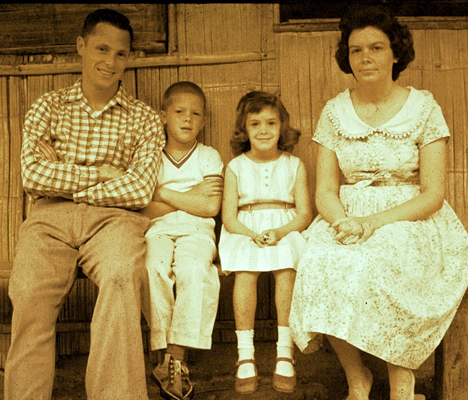 They chose Arajuno because of its close proximity to the Waorani community of Tiweno as their intention was to work among this people group. But as Martie put it, “Rachel Saint (Nate Saint’s sister) and Elisabeth Elliot (one of the widows) felt that men would not be accepted, and the Waorani remained closed to men [from the outside] for several years.”
They chose Arajuno because of its close proximity to the Waorani community of Tiweno as their intention was to work among this people group. But as Martie put it, “Rachel Saint (Nate Saint’s sister) and Elisabeth Elliot (one of the widows) felt that men would not be accepted, and the Waorani remained closed to men [from the outside] for several years.”
“As a young missionary wife and mother, Mom had some challenges of her own,” Martie related. “The weather was hot and muggy. There were bugs, spiders, snakes and germs. Occasionally we had a very real threat from the Waorani as they would come up the river either hunting game or seeking revenge [on their enemies], so we turned on the electric barbed-wire fence for protection. We had a generator that we turned on for a couple of hours at night. Mom also took care of chickens, collected and boiled water from rain barrels and kick started her washing machine like a motorcycle…. She ordered groceries by shortwave radio, and a little yellow Cessna brought them in with the mail every two weeks.”
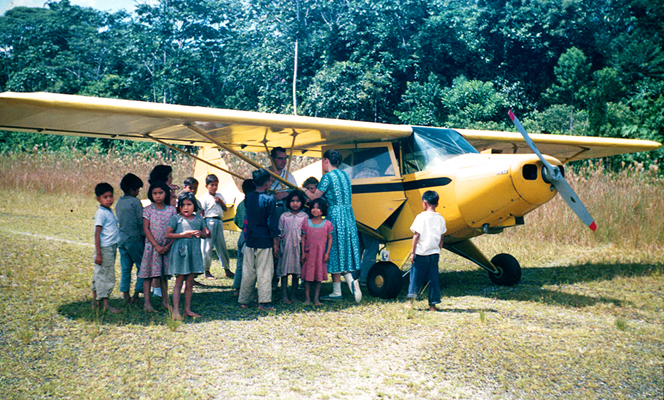 The Farstads fit the stereotype of pioneer missionaries who simply did whatever needed to be done whether it be pulling teeth, suturing machete wounds, helping people obtain land titles, fixing shotguns or delivering babies (over 50 in all).
The Farstads fit the stereotype of pioneer missionaries who simply did whatever needed to be done whether it be pulling teeth, suturing machete wounds, helping people obtain land titles, fixing shotguns or delivering babies (over 50 in all).
Producing Radio Programs
Their primary role, however, was preaching and Bible teaching, and Dick began producing Quichua radio programs for the small radio station, HCGM, in the jungle town of Macuma.
This helped prepare the Farstads for the next chapter of their lives as they transferred to Radio Station HCJB in Quito in January 1972, becoming associated with Reach Beyond for the first time. They ran the Quichua Language Service in the absence of missionaries Ralph and Gwen Horn who were leaving for home ministry assignment in the U.S.
“Dick became interested in the dialects, so he began helping with the broadcasts,” Jane related, adding that he produced programs in 23 of the 44 known dialects of Quichua and Quechua—considered as different from each other as Spanish and Portuguese.
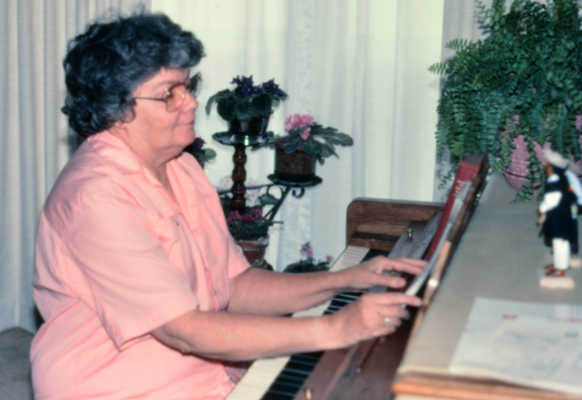 Jane assisted her husband, translating listener letters, answering correspondence and helping with the Quechua/Quichua broadcasts that could be heard by some 15 million speakers in Ecuador and several other South American countries.
Jane assisted her husband, translating listener letters, answering correspondence and helping with the Quechua/Quichua broadcasts that could be heard by some 15 million speakers in Ecuador and several other South American countries.
She also enjoyed singing in the choir for the Quito Day concerts put on by the mission each year before Christmas, coinciding with the founding of the city more than 400 years earlier. “She loved music and this was a welcome change for her,” her daughter, Martie, explained.
After hours, the Farstads were involved in both the Spanish- and Quichua-speaking congregations at Iñaquito Evangelical Church, located across the street from the mission’s campus in Quito, and they helped start a Quichua-language church.
Returning to the U.S.
In 1982, after 22 years of ministry in Ecuador, the Farstads returned to the U.S. but continued working as full-time missionaries for nearly 30 additional years, recording numerous Quechua/Quichua radio programs.
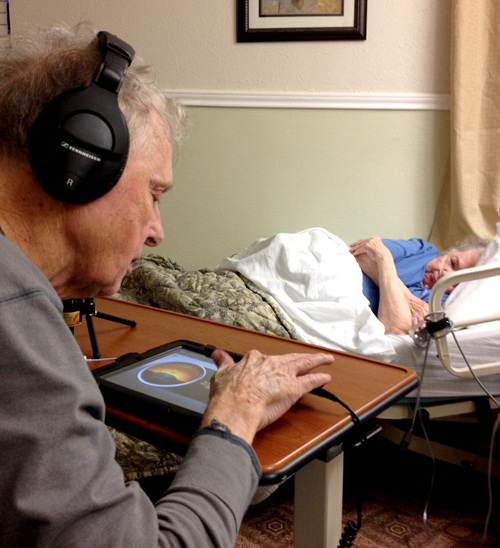 “Mom found new things to do, and for several years worked with Write-Way Prison Ministries to grade correspondence courses from prisoners,” Martie added. “She also played piano at Garland Bible Chapel in Texas while Dad became an elder there.”
“Mom found new things to do, and for several years worked with Write-Way Prison Ministries to grade correspondence courses from prisoners,” Martie added. “She also played piano at Garland Bible Chapel in Texas while Dad became an elder there.”
Several years ago, Jane suffered a stroke, and her memory began to fade, but the Farstads would continue to pray and read Scripture together. Now 85, Dick still produces a limited number of radio programs at the care center where he is living, uploading them digitally for broadcast in Ecuador.
Jane was preceded in death by two brothers, Robert and Joseph. In addition to her husband, Dick, of 62 years, she is survived by a son, Mark; a daughter, Martie (and her husband, Ted Van Den Heuvel); four grandchildren and six great-grandchildren.
A memorial service was held on Tuesday, Dec. 29, 2015, at Restland Funeral Home in Dallas with Reach Beyond missionary retiree Jim Allen officiating.
Sources: Reach Beyond, Restland Funeral Home
 But out of the ashes of this apparent tragedy on Jan. 8, 1956, arose new hope for unreached peoples worldwide. That’s because thousands of people committed themselves to missionary service after hearing this story.
But out of the ashes of this apparent tragedy on Jan. 8, 1956, arose new hope for unreached peoples worldwide. That’s because thousands of people committed themselves to missionary service after hearing this story.Among those were Richard “Dick” and Jane Farstad who went to Ecuador in 1960 to serve as missionaries with the Brethren organization, Christian Missions in Many Lands. Three of the five martyrs were members of Brethren Assemblies, and the Farstads were convinced they could make a difference by helping reach the unreached in Ecuador.
“We wanted to serve the Lord full time, and when the five missionaries were killed in Ecuador, we were drawn to that country,” Jane said in an interview several years ago.
Ima Jane (Gore) Farstad, born in St. Louis, Mo., on Oct. 26, 1925, died on Dec. 20, 2015, in Plano, Texas, after years of declining health. She was 90 years old.
As a teenager Jane attended a Young Life camp that had a big impact on her life. She gave her life to Christ at the age of 16, having no idea about the adventure or the challenges that were to come.
Preparing for Ministry
After graduating from Normandy High School in St. Louis in 1944, Jane worked as a stenographer at International Shoe Co., and five years later she decided to enroll at Emmaus Bible School, then in Chicago, completing the school’s three-year diploma in 1952. That’s where she met her husband-to-be, Dick Farstad, whom she married on July 18, 1953. Dick had graduated from the same program just months before their marriage.
Together they took part in street meetings as Dick sang in a quartet accompanied by Jane on the piano. Their two children, Mark and Martha “Martie,” were born in 1955 and 1956 respectively.
While studying at Emmaus, Dick and Jane had their first contact with Jim Elliot and Ed McCully who spoke about God’s call on their lives to serve as missionaries. Dick had had an interest in missions since he was a boy, and this talk encouraged them to consider becoming missionaries.
Still living in Chicago in 1956, the Farstads learned of the deaths of Elliot, McCully, Pete Fleming, Nate Saint and Roger Youderian. As a result, they decided to go to Ecuador to continue the work that had been started by McCully in the jungle village of Arajuno.
In preparation, Dick traveled to California to take the 14-month missionary medicine course at Biola University. Then they took training through the Summer Institute of Linguistics.
Arriving in Ecuador
In 1960 the Farstads arrived in Ecuador to serve as Brethren missionaries. After learning Spanish, they were assigned to work in the Quichua village of Arajuno where they “inherited a school, a clinic and a small [Brethren] assembly,” Jane recounted.
 They chose Arajuno because of its close proximity to the Waorani community of Tiweno as their intention was to work among this people group. But as Martie put it, “Rachel Saint (Nate Saint’s sister) and Elisabeth Elliot (one of the widows) felt that men would not be accepted, and the Waorani remained closed to men [from the outside] for several years.”
They chose Arajuno because of its close proximity to the Waorani community of Tiweno as their intention was to work among this people group. But as Martie put it, “Rachel Saint (Nate Saint’s sister) and Elisabeth Elliot (one of the widows) felt that men would not be accepted, and the Waorani remained closed to men [from the outside] for several years.”“As a young missionary wife and mother, Mom had some challenges of her own,” Martie related. “The weather was hot and muggy. There were bugs, spiders, snakes and germs. Occasionally we had a very real threat from the Waorani as they would come up the river either hunting game or seeking revenge [on their enemies], so we turned on the electric barbed-wire fence for protection. We had a generator that we turned on for a couple of hours at night. Mom also took care of chickens, collected and boiled water from rain barrels and kick started her washing machine like a motorcycle…. She ordered groceries by shortwave radio, and a little yellow Cessna brought them in with the mail every two weeks.”
 The Farstads fit the stereotype of pioneer missionaries who simply did whatever needed to be done whether it be pulling teeth, suturing machete wounds, helping people obtain land titles, fixing shotguns or delivering babies (over 50 in all).
The Farstads fit the stereotype of pioneer missionaries who simply did whatever needed to be done whether it be pulling teeth, suturing machete wounds, helping people obtain land titles, fixing shotguns or delivering babies (over 50 in all).Producing Radio Programs
Their primary role, however, was preaching and Bible teaching, and Dick began producing Quichua radio programs for the small radio station, HCGM, in the jungle town of Macuma.
This helped prepare the Farstads for the next chapter of their lives as they transferred to Radio Station HCJB in Quito in January 1972, becoming associated with Reach Beyond for the first time. They ran the Quichua Language Service in the absence of missionaries Ralph and Gwen Horn who were leaving for home ministry assignment in the U.S.
“Dick became interested in the dialects, so he began helping with the broadcasts,” Jane related, adding that he produced programs in 23 of the 44 known dialects of Quichua and Quechua—considered as different from each other as Spanish and Portuguese.
 Jane assisted her husband, translating listener letters, answering correspondence and helping with the Quechua/Quichua broadcasts that could be heard by some 15 million speakers in Ecuador and several other South American countries.
Jane assisted her husband, translating listener letters, answering correspondence and helping with the Quechua/Quichua broadcasts that could be heard by some 15 million speakers in Ecuador and several other South American countries.She also enjoyed singing in the choir for the Quito Day concerts put on by the mission each year before Christmas, coinciding with the founding of the city more than 400 years earlier. “She loved music and this was a welcome change for her,” her daughter, Martie, explained.
After hours, the Farstads were involved in both the Spanish- and Quichua-speaking congregations at Iñaquito Evangelical Church, located across the street from the mission’s campus in Quito, and they helped start a Quichua-language church.
Returning to the U.S.
In 1982, after 22 years of ministry in Ecuador, the Farstads returned to the U.S. but continued working as full-time missionaries for nearly 30 additional years, recording numerous Quechua/Quichua radio programs.
 “Mom found new things to do, and for several years worked with Write-Way Prison Ministries to grade correspondence courses from prisoners,” Martie added. “She also played piano at Garland Bible Chapel in Texas while Dad became an elder there.”
“Mom found new things to do, and for several years worked with Write-Way Prison Ministries to grade correspondence courses from prisoners,” Martie added. “She also played piano at Garland Bible Chapel in Texas while Dad became an elder there.”Several years ago, Jane suffered a stroke, and her memory began to fade, but the Farstads would continue to pray and read Scripture together. Now 85, Dick still produces a limited number of radio programs at the care center where he is living, uploading them digitally for broadcast in Ecuador.
Jane was preceded in death by two brothers, Robert and Joseph. In addition to her husband, Dick, of 62 years, she is survived by a son, Mark; a daughter, Martie (and her husband, Ted Van Den Heuvel); four grandchildren and six great-grandchildren.
A memorial service was held on Tuesday, Dec. 29, 2015, at Restland Funeral Home in Dallas with Reach Beyond missionary retiree Jim Allen officiating.
Sources: Reach Beyond, Restland Funeral Home
